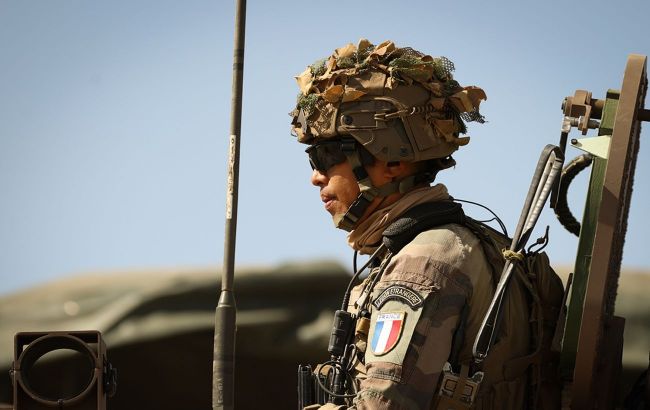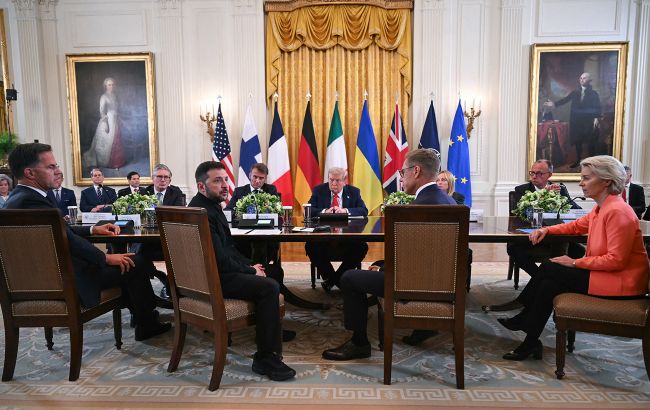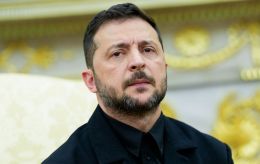US and Europe pledge security guarantees for Ukraine. Can they shield from new Putin's invasion?
 French soldier during training exercises in Senegal (photo: Getty Images)
French soldier during training exercises in Senegal (photo: Getty Images)
Security guarantees for Ukraine have become one of the key topics in negotiations to end the war. RBC-Ukraine analyzes what Western partners are promising Kyiv and how effective their guarantees could be.
Key questions
- What security guarantees were previously offered to Ukraine?
- What new items have been added to the agenda?
- Will the NATO Article 5 model be effective?
- What is preventing Europeans from sending troops to Ukraine?
Immediately after the meeting between US President Donald Trump and Vladimir Putin, American officials made statements about providing security guarantees to Ukraine. This topic was also one of the main ones during the meeting between Trump, Zelenskyy, and European leaders this week.
These are mechanisms similar to Article 5 of the North Atlantic Treaty, which led to the creation of NATO. However, they will not be provided through the Alliance. In addition, the guarantees will provide for the strengthening of the Ukrainian Armed Forces without restrictions on numbers or other limitations that Russia might demand as part of a peace agreement. Another component under discussion is the deployment of European troops in Ukraine. This is the general concept, but as always, the devil is in the details.
Previous ideas
The idea of creating security guarantees for Ukraine in one form or another is not new. It was first seriously discussed in September 2022. At that time, Ukraine proposed the Kyiv Security Compact.
This idea was further developed in July 2023. On the sidelines of the NATO summit in Vilnius, the leaders of the G7 agreed on a joint declaration of support for Ukraine. In the document, they noted that each country would work with Kyiv on bilateral long-term commitments and agreements in the field of security.
As a result, Ukraine and its Western partners signed 28 bilateral agreements on security cooperation. Each country had its specific conditions. Some of them committed to allocating a certain percentage of financial aid to Ukraine in their budgets for the coming years. In other agreements, partners promised to provide Ukraine with weapons, train Ukrainian military personnel, or cooperate on cyber defense.
However, most of the agreements did not specify the provision of security guarantees to Ukraine in the event of a new Russian attack. For example, the agreement with the US and the UK only provides for urgent consultations. Germany, on the other hand, is committed to providing immediate military support, including modern air defense systems and artillery.

Meeting in Washington (photo: Getty Images)
The next round of discussions on security guarantees began this winter, after Trump returned to the US presidency. French President Emmanuel Macron and British Prime Minister Keir Starmer launched a discussion on the deployment of European troops in Ukraine.
However, a final model for European participation was not worked out at that time. Statements by European politicians referred to peacekeepers, contingents, and even simply missions with a vague mandate. However, according to RBC-Ukraine, the deployment was prepared quite thoroughly. Several technical preparatory delegations visited Ukraine.
European leaders also wanted to secure US support, at least in terms of logistical assistance, air defense cover, and intelligence. But Trump showed little interest at the time. So, with the negotiation process stalling, the topic of peacekeepers gradually faded away.
This does not mean that the work was forgotten. After meeting with Trump, NATO Secretary General Mark Rutte said that a group of 30 countries had been working on security guarantees for several months.
"The initiatives differ quite significantly from one another, but at the moment there are attempts to combine several of these elements," says Hanna Shelest, director of security programs at the Ukrainian Prism Foreign Policy Council.
Although most of the formats are being pushed by Europeans, it is the position of the US that is decisive. And here, judging by Trump's rhetoric, there are positive changes. At a meeting with Zelenskyy, Trump seemed much more sympathetic to the idea of guarantees than he was a few months ago, according to informed sources at RBC-Ukraine. At the same time, two issues remain problematic. The first is the specifics of applying security guarantees. The second is the forces that are to implement the guarantees on the ground.
Attack on one is (not) attack on all
Article 5 of the NATO Treaty establishes the principle of collective defense, according to which an attack on one member of the Alliance is considered an attack on all. However, according to Hanna Shelest, even this model is rather vague. Article 5 goes on to say only that each NATO country will immediately assist the party or parties that have been attacked and will take such measures as it deems necessary.
"This does not resolve the issue of effective implementation if there is a lack of political will. However, compared to previous agreements, this is a step forward (in terms of security guarantees for Ukraine — ed.), because NATO did not want to give us Article 5," Shelest says.
In practice, this could take the form of a separate bilateral or multilateral agreement. If the document is multilateral, it will have a much stronger deterrent effect on Russia in the future.
The option of a separate agreement was mentioned, in particular, by US Secretary of State Marco Rubio in an interview with Fox News. He stated that Ukraine would have the right to enter into new defense alliances. As an example, he cited US agreements with Japan and South Korea.
For example, the agreement with Japan stipulates that in the event of an attack on that country, the US is obliged to provide military support, but specific actions depend on the decision of the US government. In general, the response mechanism is less formalized than in NATO. And this is a serious drawback. The advantage of NATO is that the alliance has a developed civil and military infrastructure for collective defense, says Serhii Dzherdzh, head of the Ukraine-NATO League.
"There is a game being played with Russia here, on the one hand to give us guarantees, and on the other hand to avoid unnecessary objections from Putin," the expert says.
In general, this approach is workable and does not contradict NATO's charter. There have been cases in history when NATO member states waged wars on their own, but the Alliance did not intervene. For example, in 2003, the US assembled a separate coalition against Iraq, and 10 years later, France sent troops to Mali on its own. Therefore, in each case, NATO member states will make a separate decision.
"Roughly speaking, if the United States decides on its own to wage war somewhere in China, and China attacks them, then the US can turn to the Alliance. NATO could theoretically say: You started this war yourselves, so we cannot apply Article 5," Hanna Shelest explains.
In any case, negotiations on the legal formalization of guarantees are ongoing, and many issues still need to be agreed upon. In particular, given the position of Russia. Immediately after the meeting in Alaska, Trump said that Russia was allegedly not opposed.
"In a very significant step, President Putin agreed that Russia would accept security guarantees for Ukraine, and this is one of the key points that we need to consider, and we’re going to be considering that at the table, also who will do what essentially," says the US President.
However, there are no other sources that can confirm Russia's agreement to the guarantees. Likely, the Kremlin will still try to use this card in further negotiations.
Boots on the ground
The situation regarding the deployment of troops to Ukraine is more complicated due to Russia's tough stance. Unlike security guarantees, the presence of troops, even in rear cities, is more visible and will directly indicate that the goals of the special military operation for Russia have not been achieved.
"We confirm our repeatedly stated position of categorical rejection of any scenarios involving the deployment of military contingents in Ukraine with the participation of NATO countries," Russian Foreign Ministry spokesperson Maria Zakharova said on August 18.
At the same time, Axios, citing sources, notes that during a meeting in Alaska, Putin mentioned China as one of the possible guarantors of Ukraine's security, which may indicate that Russia will oppose security forces formed solely from NATO troops.
 French military (photo: Getty Images)
French military (photo: Getty Images)
British Defense Minister John Healey said on August 15 that his country is ready to send troops to Ukraine to support a possible ceasefire if an agreement is reached. Other countries remain more cautious. But the US position may give them more resolve.
"They want to have boots on the ground. I don’t think it’s going to be a problem, to be honest with you," Trump suggested during a conversation with journalists on August 19 in an interview with Fox News.
According to him, if European countries are ready to provide their troops, then the United States can focus on providing air cover.
"Europeans need guarantees from the United States for themselves, first and foremost. In the event of war, if their contingents are deployed, this should be coordinated with the US, and the US should at least join in supporting these contingents," Serhii Dzherdzh says.
Today, August 20, NATO military leaders plan to meet to discuss the situation in Ukraine and their next steps. In addition, a planning group meeting with representatives from Europe and the US will take place in the coming days.
Ultimately, however, the specific size of the contingent and its deployment locations will be determined through political agreements.
"This will depend, in particular, on the format of the completion of the current stage. That is, we will talk about a truce or permanent peace, the current line of demarcation, or other things," emphasizes Hanna Shelest.
All this should become clear during the next summit meeting, possibly even in the format of Zelenskyy-Trump-Putin. But for now, conflicting statements from the US and Russia regarding the contingent mean that negotiations on security guarantees for Ukraine will not be easy.
Sources: Ukrainian, American, and European politicians, Axios, Bloomberg, Reuters, Fox News, and The New York Times, comments by Hanna Shelest and Serhii Dzherdzh.

